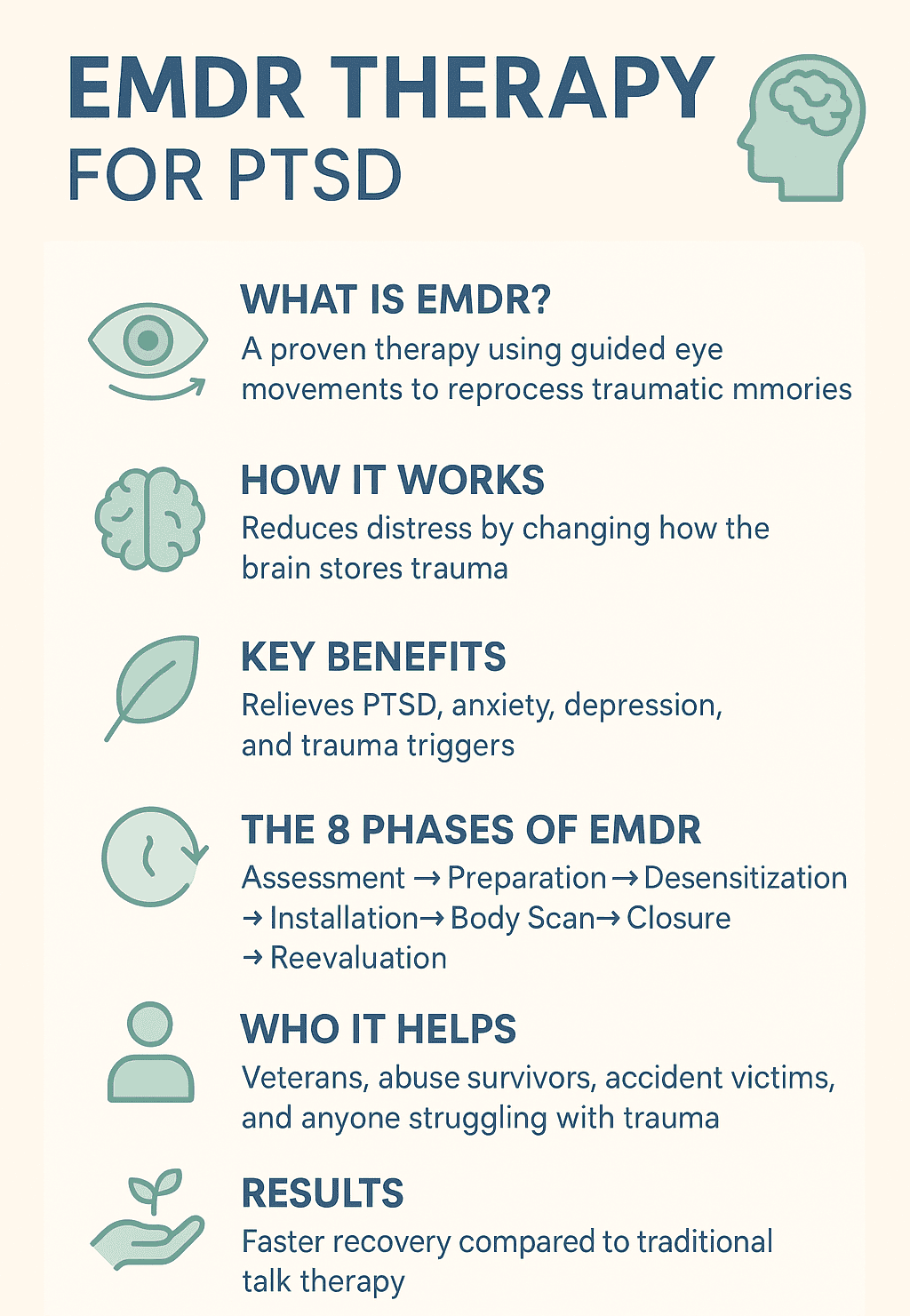Moments before initiating EMDR (Eye Movement Desensitization and Reprocessing) therapy can be quite intimidating. Those who have never taken the help of psychotherapists or counsellors may wonder what conversations might take place behind the closed doors of the clinic.
To relax those who are skimming through search results of “EMDR therapist near me,” anxiety and trauma counseling therapy, which is known to provide relief from PTSD and a handful of other troubles, utilizes the Bilateral Stimulation method.
EMDR Therapy Near You: What to Expect from Therapist in Your First Session
EMDR therapy especially helps with PTSD, and in addition to that, anxiety, as well as phobias. PTSD. Clearly, as the name suggests, it stems from past events that left a significant mark on their memory and thought process. Sometimes, prolonged circumstances that are traumatizing can also impact an individual in an adverse way. In order to help navigate a healing journey after such happenstance(s), EMDR therapy is essential.
However, in your initial sessions, you won’t have to worry about that. During the first few sessions, you can expect to talk about your life trajectory, any past trauma (if you are comfortable talking about it), and your current circumstances, as well as symptoms.
What exactly is EMDR Therapy?
At its core, EMDR therapy for PTSD is a refined psychotherapeutic technique built to untangle the weight of traumatic imprints and memories that cling too tightly.
Unlike conventional talk therapy, where narration alone carries the healing arc, EMDR invites the brain into active reprocessing through bilateral stimulation like eye movements, tactile tapping, or alternating sounds.
Over repeated sessions, painful recollections soften; they lose their sharp edges, no longer overwhelming daily thought. Instead of haunting, they settle, allowing space for clarity and calm to re-emerge.
Why People Gravitate Toward EMDR Therapy
The reasons for seeking EMDR therapy vary, but most roads leading here are paved by deep-rooted emotional burdens:
- Unresolved shock from calamities such as assaults, severe accidents, or natural disasters.
- Post-Traumatic Stress Disorder (PTSD), accompanied by intrusive flashbacks and constant hyper-alertness.
- Lingering anxiety or panic attacks that resist traditional interventions.
- Phobias that shrink daily possibilities.
- Entrenched negative self-beliefs are born in childhood or post-relational wounds.
For many, the very first session isn’t about diving headfirst into trauma. It’s about exploring whether this therapeutic compass points in the right direction for their healing journey.
First Consultation - Before the Session Even Begins
Typically, a therapist arranges a preliminary consultation, through a call or video, where foundations are laid. Practical questions about session length, cost, or scheduling are answered.
More importantly, you get to sense whether the therapist’s style resonates with your comfort zone. Therapy is not just a method; it’s a way to find calm within.
The Anatomy of a First EMDR Session
Though everyone’s entry into eye movement therapy is unique, the first session tends to carry a steady structure:
- Building Trust and Safety: The beginning often feels conversational, not clinical. You’ll be invited to share history, challenges, and personal goals. Rather than opening painful memories at once, the emphasis is on anchoring safety and rapport. Healing can only unfold in trust.
- Exploration and Assessment: Your therapist may gather details, health background, past therapies, emotional triggers. They’ll also introduce you to EMDR’s stages, clarifying that the deep reprocessing work doesn’t happen immediately. The groundwork must be steady before the climb.
- Learning Stabilization Tools: Before any excavation of trauma, most therapists equip you with coping tools: grounding practices, controlled breathing, and guided imagery. These become your emergency kit should strong emotions rise later. Think of it as learning how to steady the rope before crossing the bridge.
- Gentle Introduction to Bilateral Stimulation: Rather than leaping into heavy memory work, your therapist may demonstrate the bilateral process, hand movements for your eyes to follow, or light rhythmic tapping. This preview is about familiarity, not intensity.
- Mapping Out What Comes Next: Finally, you’ll discuss future sessions: which memories may be addressed, the frequency of appointments, and how progress will be measured. EMDR respects pace; it is never a hurried march, but a guided, careful walk.
Feelings That Often Follow the First Session
Stepping out of that first session, emotions can be mixed. Relief at having voiced long-buried pain. Curiosity about what’s ahead. Perhaps a touch of unease as deeper layers stir.
None of these responses are wrong; they’re all part of the terrain. EMDR therapists usually remind you to use grounding skills between sessions, ensuring you remain steady as your mind begins to shift.
The Promises of EMDR Over Time
- When practiced consistently, EMDR opens doors to:
- Traumatic memories loosen up their painful grip.
- A sturdier, kinder self-image.
- Greater ability to withstand triggers without spiraling.
- Fewer nightmares and intrusive flashbacks.
- An overall sense of steadiness, confidence, and renewed possibility.
Is EMDR a Universal Fit?
Though EMDR is one of the most researched trauma therapies, it is not a one-size solution. Some people need extended preparation before tackling memory reprocessing.
Others may benefit more from blending EMDR with talk therapy or different modalities. A capable therapist carves the journey; no rush, no force, only alignment with what feels manageable and healing at your pace. If you are looking for trauma therapy near you, get in touch with Town Psychology today.
EMDR has been widely researched and proven effective. However, it may not be the best fit for every individual out there. Some people require longer periods of stabilization before beginning reprocessing.
This can be attained with breathing practices and Cognitive Behavioural Therapy (CBT). At the same time, others may find EMDR works best when combined with talk therapy or other approaches. A skilled therapist will tailor the treatment plan to your needs, ensuring you move at a pace that feels manageable.
In a nutshell…
You can definitely brush off those jitters you might get before the first therapy session. Our therapists will ensure that the patients always feel safe and comfortable. You won’t have to push yourself to share something that doesn’t come easily to you. Initial sessions will be more like having a strong foundation before the journey of therapy begins.
FAQs
How long does EMDR therapy usually take?
Any therapy method can start showing some impact after 10-12 sessions. However, it depends on the patient and other complexities.
Apart from PTSD, where does EMDR help?
EMDR helps with issues like anxiety, phobias, grief, depression, and negative self-beliefs.
Do I need to prepare for my first EMDR session?
There is no specific preparation needed. Just be comfortable, feel free. It might help to bring a notebook, a pen, and a water bottle.
Is it necessary that I will have to talk about all the details of my trauma?
No, you can share what you feel like sharing. Nothing more than that.


